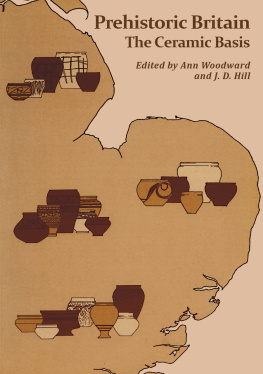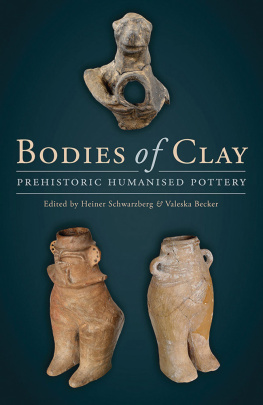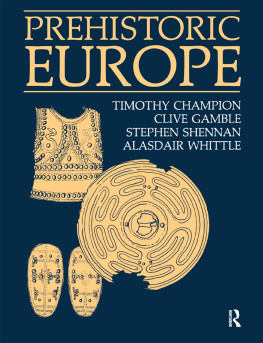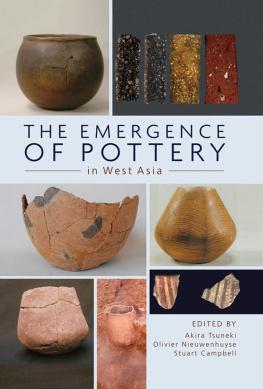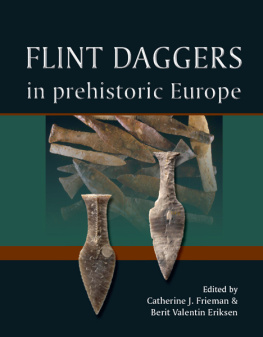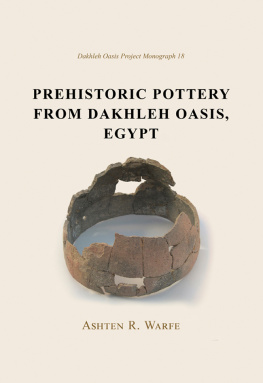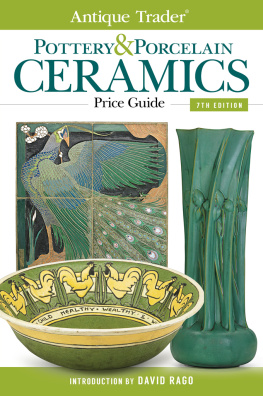
Prehistoric Ceramics Research Group Occasional Publication 3
Prehistoric Britain
The Ceramic Basis
Edited by
Ann Woodward and J. D. Hill
Oxbow Books
First published in the United Kingdom in 2002. Reprinted in 2017 by
OXBOW BOOKS
The Old Music Hall, 106108 Cowley Road, Oxford OX4 1JE
and in the United States by
OXBOW BOOKS
1950 Lawrence Road, Havertown, PA 19083
Oxbow Books and the individual authors 2002
Paperback Edition: ISBN 978-1-84217-071-7
Digital Edition: ISBN 978-1-78570-533-5
Mobi Edition: ISBN 978-1-78570-534-2
A CIP record for this book is available from the British Library
All rights reserved. No part of this book may be reproduced or transmitted in any form or by any means, electronic or mechanical including photocopying, recording or by any information storage and retrieval system, without permission from the publisher in writing.
For a complete list of Oxbow titles, please contact:
UNITED KINGDOM
Oxbow Books
Telephone (01865) 241249, Fax (01865) 794449
Email:
www.oxbowbooks.com
UNITED STATES OF AMERICA
Oxbow Books
Telephone (800) 791-9354, Fax (610) 853-9146
Email:
www.casemateacademic.com/oxbow
Oxbow Books is part of the Casemate Group
Foreword
The human clay
Studies of prehistoric pottery have changed dramatically, and many of the more exciting developments are considered in this book. A few years ago one might be forgiven for thinking that the main purpose of archaeological fieldwork was to recover pottery and that the only point of publishing that material was because, like Everest, it was 'there'.
Not any more. With a new generation of studies of material culture studies that seek to locate it at the heart of a modern archaeology artefact analysis has been rejuvenated. Although aretfacts can, and should be used to investigate questions of chronology, now they have other, equally important roles to fulfil. It is not for me to spell these out as this is done most effectively by the contributors to this volume.
But why pottery rather than other kinds of artefact? These essays mount a powerful case that ancient ceramics were central to many aspects of prehistoric social life. They are no longer considered important just because they were common. It is clear that pottery, and the clay from which it is made, has a powerful metaphorical role in many societies. This is well argued here, but I had not realised quite how powerful those links might be until I was looking for a title for this piece. I wanted to check whether The human clay' had been used before. In the course of my search I discovered innumerable book titles that play on the same association between people and ceramics. Here is a small selection:
Brothers in Clay; Children of Clay; The Healing Power of Clay; I am the Clay; Impassioned Clay; Living Clay; Of Blood and Clay; Singing the Clay; The Spirit of the Clay; Talking with the Clay; When the Clay Sings; Talking Pots; Ceramic Gestures; Communicating Vessels; Vessels of Honour; Vessels of Faith; and (even) Vessels of Evil
There are other titles that are more eccentric but they seem to be making the same point: the processes of potting are fundamental to human understanding of the world. These are a few of my favourites:
The Clay Machine Gun; I Know What Red Clay Looks Like; God Uses Cracked Pots; and, strangest of all, I Been in Sorrow's Kitchen and Licked Out All the Pots.
'The human clay', my own title, carries the same emphasis. Ceramics are no longer a specialist preserve, cut off from the main currents of contemporary archaeology. They are central to the whole enterprise. This interesting book tells us why.
Richard Bradley
1 Introduction
Ann Woodward and J. D. Hill
Pots are very closely related to people. Across the world, the terms applied to different parts of baked clay vessels are derived from descriptions of parts of the human body (). Nigel Barley has stated that Tots lend themselves to thinking about the human form' and observes that in West Africa this rich imagery recurs as a major cultural theme (Barley 1994, 85). But we need to ask why this should be so. One possible answer is that in many societies, both ancient and modern, it is pots that form the vehicle whereby two of the essential requirements of human life food and water are introduced into the human body itself. The other crucial human requirement is heat and warmth, and it is this property that is engaged to make the pots in the first place. The transformation of clay, part of the living earth, by fire, creates an entirely novel and man-made material a medium which is both malleable, plastic and highly versatile becomes, when fired, a hard, rigid and highly fragile category of material culture. However the theme can be developed even further, because it is through the application of heat to the finished pots that liquids may be heated, and foodstuffs cooked. So, the beverage passes from the lip and mouth of the cup to the human lips and mouth, and warm food from the belly of the jar enters the human stomach.
This fundamental and close connection between pottery vessels and the human body suggests that pottery might be a powerful indicator for many of the things that we wish to know about people in prehistory. For instance, we need to investigate how people lived, worked and subsisted on a daily basis, how their activities varied by the seasons, how they celebrated festivals and rites of passage at home and with other people, how they interrelated and socialised with their neighbours at local and regional levels, and how they related to the world around them. We believe that the enlightened study of pots can go a long way to inform many of these lines of enquiry. This is partly due to the close corporeal symbolism outlined above, but also to some key aspects of ceramic technology and usage.
Firstly, fragments of pottery survive well in the soil. Amongst the wide-ranging categories of raw material used during prehistory metals, bone and antler, flint and stone, fur, leather, reeds/withies, wood and bark, lithic items are the only artefacts that survive as well as potsherds. Therefore there are substantial quantities of pottery to be discovered and studied. Secondly, due to its exceptional plastic qualities, clay can be crafted in a multitude of ways it is conducive to the production of vessels of widely ranging size, shape and style which may be adorned with surface treatments and decoration executed in myriad techniques. The subtle changes of these parameters through time and space mean that pottery provides a powerful tool for the analysis of chronological change and for the study of changing style within individual homesteads and larger settlements, as well as across neighbourhoods and regions. Thirdly, clay pots form versatile and convenient containers. Whilst baked clay was used for other purposes, notably for ovens, hearths, walling, whorls and perforated weights and (though not in Britain) to mould anthropomorphic or animal figurines, its prime usage appears to have been in the production of vessels.
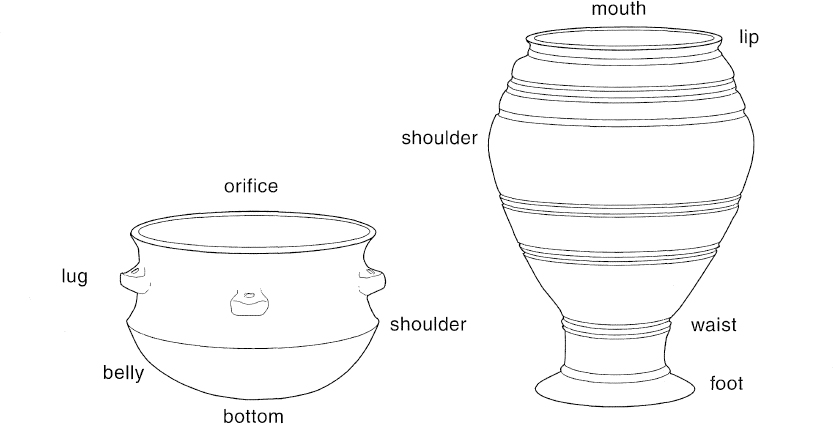
Fig. 1.1. Pots as bodies.
This brings us back to our first topic, as vessels were involved primarily with the manipulation of food and drink. The multifarious functions of pottery in this realm can be divided into three main areas of activity: storage of commodities, heating and cooking, and finally, the presentation and serving of foodstuffs and beverages. The invention and adoption of pot making and a more home-based existence (Ian Hodder's domus 1990a) from the Neolithic onwards allowed the art of cooking to be developed in far-reaching and exciting ways. Previously many wild plant foods would have been consumed in a raw state, as may some animal products, although there is evidence for the roasting of meat, and some may have been boiled in animal skin containers. However, clay pots immediately allowed the opportunities to cook food in many more ways: boiling, simmering and stewing probably were the mainstays of the possible new techniques, but the methods of poaching, frying and steaming no doubt also were employed. Prehistoric societies were able to enter new realms of food preparation truly a prototypical nouvelle cuisine. At the same time the potential to manufacture vessels of many different sizes, shapes and styles meant that customs of presenting food, drink and drugs, both at the domestic and communal levels could be elaborated to a high degree. The shapes, colour, texture and decoration of pottery vessels could be developed to signify kinship or status, and to act as symbolic markers relating to many spheres of social and spiritual life. These are the sorts of connections that this book is intended to address.

